All the way from issue 69 – here’s an interview with the Scottish Oaken-Calved Troubador himself, Jon Meredith:
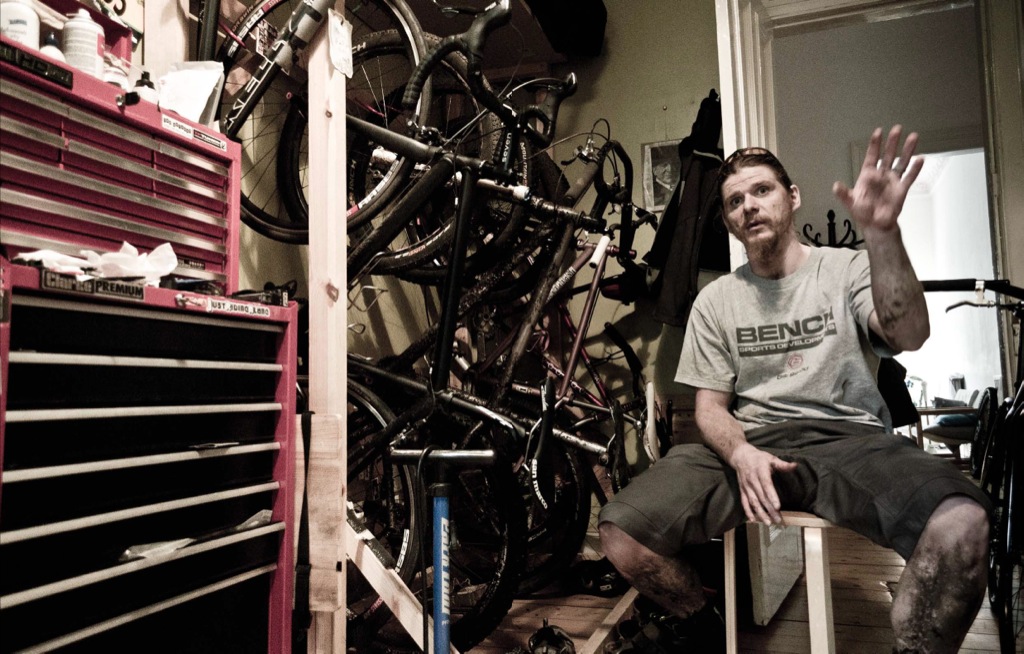
One man’s search for the perfect bike – through buying, converting, adapting, customising and tweaking beyond recognition.
Every now and then you come across someone who likes to do things a bit differently. Someone with a bike that appears to be as far away from an off-the-peg normal bike as you can possibly get. More often than not such people are simply annoying just-to-be-different attention seekers. And usually they can’t ride a bike for toffee. Jon Meredith – or Dr Jon as he’s known by some – is not such a person. Yes, his bikes are mental-looking. And eye-wateringly expensive. But he can ride the pants off pretty much anyone. And his bikes aren’t in the least bit showy. So how has Jon ended up with his collection of fruity bikes? Fundamentally it’s due to an obsession with chasing perfect solutions. As he’s gone through the years his bikes have become more and more specific to what they do. “When you get something that’s optimised for the task at hand it’s just beautiful” he preaches. In this feature we get Jon to explain himself and his move from Specialized bikes to specialised bikes.
Specialized Hardrock and Unloved Diamondbacks
Latest Singletrack Merch
Buying and wearing our sustainable merch is another great way to support Singletrack
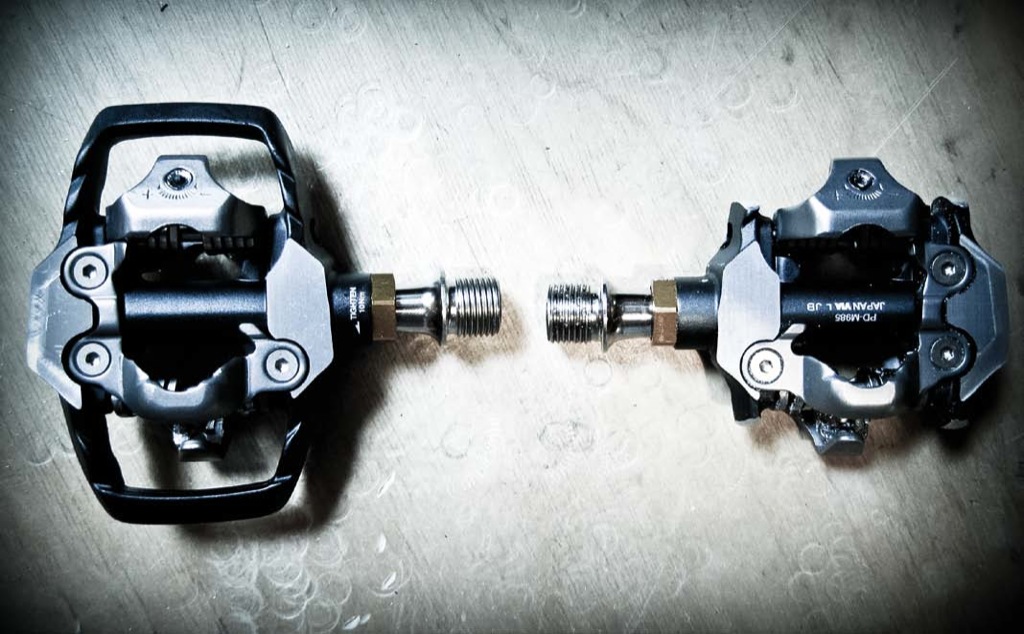
Biking Beginnings
The first mountain bike Jon got was a late ’88 or ’89 Specialized Hardrock. Typically due to it being a parents-sponsored purchase it was a ‘He’ll grow into it’, 21.5in frame. It would be too big for him even now. Having said that, the bike was good enough to get him hooked on this mountain biking stuff. Even though a youngster Jon kept breaking stuff on the bike. Broken wheel axles at that time were the thing. Swiftly followed by bust bottom brackets.
After about 18 months of slowly killing the Hardrock, it was time for a new bike. There was a character called Ian George who had Claymore Cycles, a dingy little place near Newhaven just beyond Leith. He was a DiamondBack dealer. He had this dingy little shop which could be a reason why Jon has a dingy little room with lots of bike stuff in it. Ian didn’t have any shelves or anything like that. Just boxes and boxes of stuff. He was a bit surly but he had good advice if pressed. He sold bike frames and Jon got a couple of DiamondBacks, a steel one and then his first aluminium frame. He had those for a very brief amount of time. He was never very happy with them but they were things that he could afford.
1993 Kona Cinder Cone
A friend of Jon’s acquired a Kona. This bike seemed to revolutionise everything. The handling it offered was on another level. Jon wanted a Kona. Jon got a Kona. A 1993 Kona Cinder Cone that he loved dearly. This was the start of Jon messing about with setup. He deliberately bought a bigger than recommended frame size so he could run a much shorter stem. He’d pull bits off and put other bits on. Constantly changing tyres. This wasn’t massively common behaviour in those days.
Unfortunately, that bike got stolen. A brutal day “spent chasing a wee thief up the road” as he disappeared into the distance. Jon then went through a succession of Konas very quickly. Changing things really, really rapidly. Eventually running them as bodged singlespeeds. Why single speeds? “They were so light. They never wore out. Just perfect for riding in Scotland. And there was a bit of a ‘scene’ as well you know. I gave up riding with gears for years and years.”
The First-Pay-Cheque Posh Bike
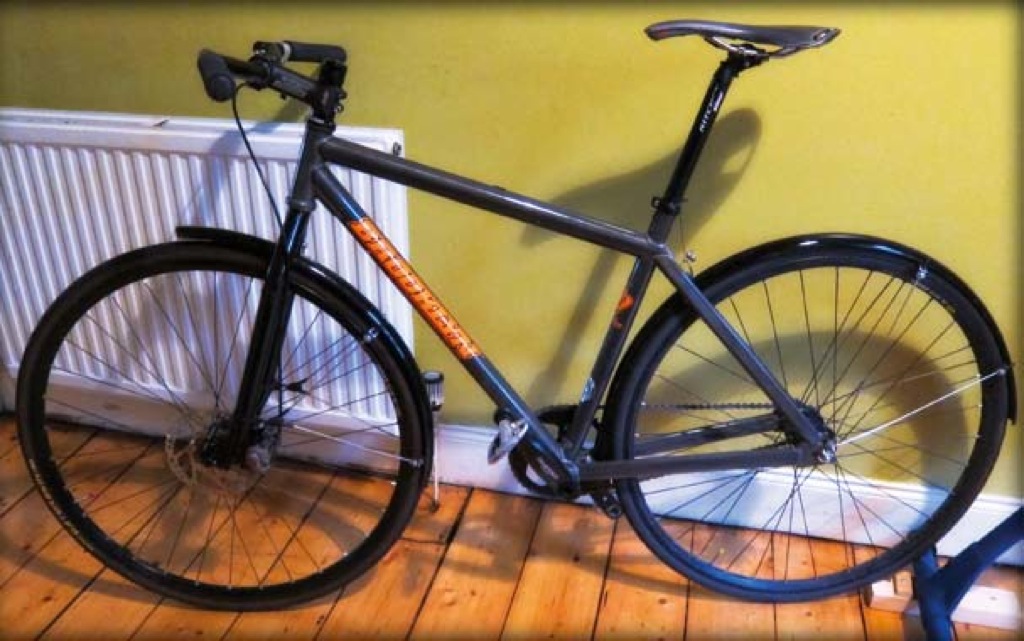
Seven Ti
Jon started work as a hospital doctor. With his first pay cheque he bought an expensive bike. A titanium frame from Seven. He’d always had a thing for Wilderness Trail Bikes and the geometry of the Seven was pretty much a match for a WTB Phoenix. The Seven was set up with a lot of WTB’s Grease Guard components, the stuff with grease ports and lots of seals. Set up to survive year round riding in Scotland really. “It’s pretty abusive on bikes here. Stuff needs to last.” The Seven was Jon’s first committed singlespeed that he’d actually spent some money on and thought about.
The Unexpected Big Wheel
Kelly Roshambo
And then Jon bought a 29er on pretty much a whim. A Kelly Roshambo. 29ers were just getting started. They were very much the new thing from America. Kelly bikes were candy coloured and colour-coordinated. Just really nice looking bikes that would catch anyone’s eye. “I’d always had a lot of time for Mike Ferrentino’s reviews [for Bike Mag] and he seemed to like the Roshambo so I went for it. And it ruined me! I gave up 26in wheels”.
With the Kelly, Jon was an instant convert. For the sort of riding he likes doing. “I like doing distance stuff. Slow, technical, picky kinda riding. And just the simple fact the bottom bracket drop, axle line, is so great on them, you’re so inside the wheels. I just found I could ride stuff that I couldn’t ride on a 26er. And once you get them going, they just cover ground so well.”
One of the first rides on it was a duathlon race at Glentress. Jon is a crap hill runner; far too heavy. But he did really, really well on the ride. His fate was sealed. “That was the ride where I really knew that 29ers were the thing, for lots of different reasons, for me. It was nowhere as special as the Seven in terms of looks or build-up but I just preferred it. Every time I reached for a bike I reached for the Kelly.”
New Job, New Bike
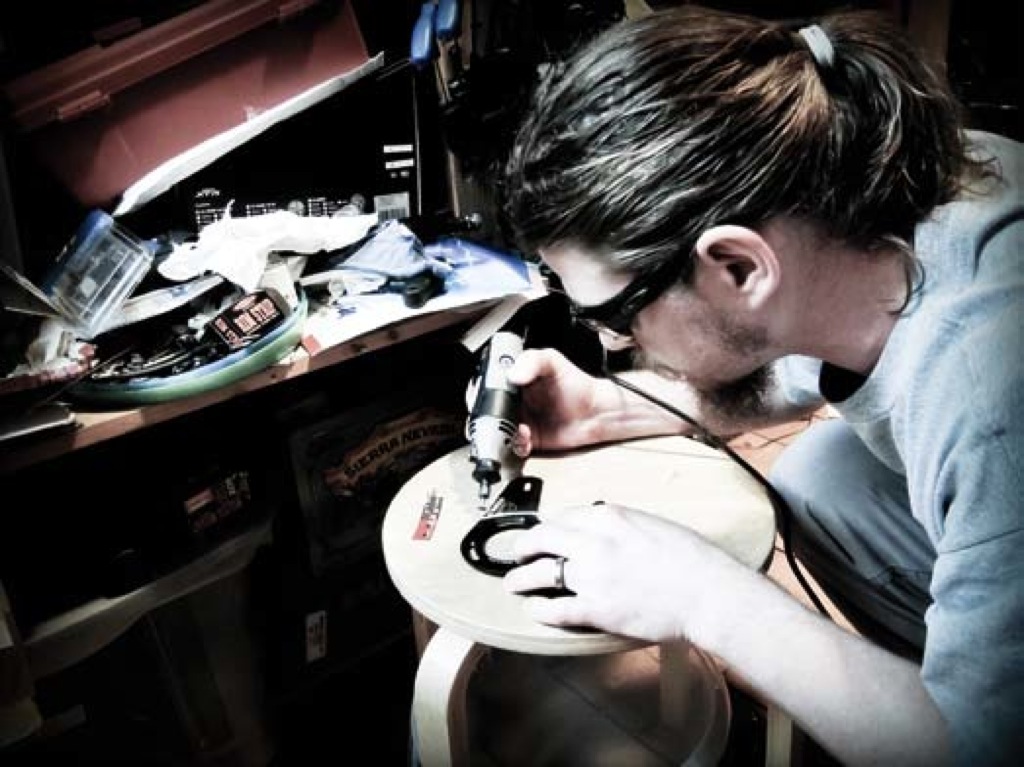
Independent Fabrication Ti 29er
A change of jobs meant a lump sum. Jon bought a titanium Independent Fabrication 29er. At the time the geometry of 29ers tended towards really steep head angles, which was not what Jon wanted: “A 72° head angle is no good as you end up with the bike folding over and jack-knifing under you”. With the Indy Fab it was about as relaxed as you got at that time. That was a “beautiful bike”. Jon loved it. He rode it all over the place. He raced it. Did big days out. But, “it still had a tendency to steer underneath me in steep stuff.”
It was at this point that Jon started to really think about bike geometry, rather than just copy things that already existed.
The Somewhat Inevitable Jeff Jones
Jeff Jones Ti Spaceframe
Jon met Jeff Jones through a mutual friend. Jeff’s geometry was a totally different thing. Laid back, short. “Very, very quick steering but stable”. But what about the infamous H-Bars? “I HATED the looks of them, absolutely hated. And I couldn’t stand the fact I liked them. Because I liked very simple looking bikes – rigid singlespeed, straight flat bars, no extra stuff on it. Then you stick these kinda weird looking things on. Everybody speaks to you about them. Laughs at them. But they worked, for me. So… damn!”
So then Jon got a Jones, and loved it. He also loved learning about geometry. “Fork rake and stuff, and learning how it all goes together. There’s not one bit that makes it work, it’s the whole thing together. The position on the bike, weight distribution, it’s all got to work together for you doing what you do. A bike’s got to ride well.”
It’s Not Touring, It’s Bike-Packing
Independent Fabrication Custom
Then he got into bike-packing and got a custom Independent Fabrication, which was very slack for a 29er. It was designed for bike-packing and was ideal for that. Very low, very long, slack. “You might think it’s a bit boring to ride at first, it can sometimes take a wee while to go round corners but it’s just great for the intended use. And it was a pointer towards new things; really liking the slack geometry.”
A New Bike For A New Type Of Riding
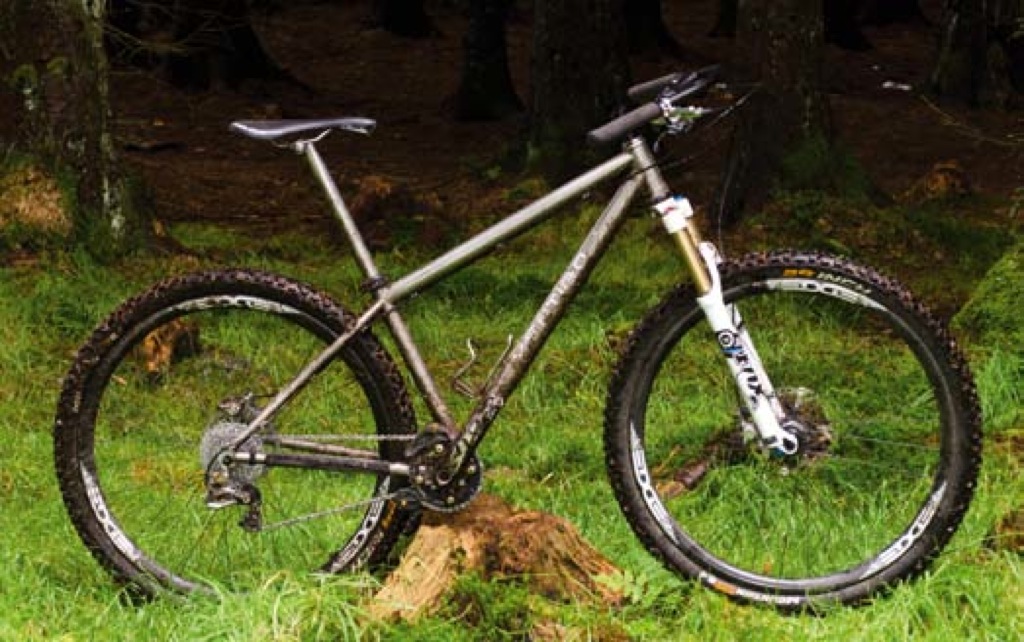
Vertigo Custom
Jon had seen the development of riding on hardtails in Britain with the big fork and slack angles and all the rest of it. “I knew that sort of fitted with what I liked about bike handling. But I hadn’t had a suspension fork for about eight years. But rigid singlespeeds beat you up after a while! Especially on some of the things that I wanted to be riding.” So he wanted a bike with a suspension fork. And if he was going to get a bike with a bouncy fork he might as well get a proper fork. 120mm was as big a travel as you could get on 29ers at the time.
The Vertigo was for bigger stuff. More technical. Bigger days out on the hills. With gears. “Singlespeed is great but you are a little bit limited at the end of the day.” It initially had a bit of weird rear wheel on it: a 150mm rear hub with a singlespeed cassette body on it that took a milled-down, six-speed cassette. Zero offset. Dish-less. Jon was preoccupied with wheel stiffness for a while. But the wheel on the bike now is a fairly normal nine-speed setup – “Because I liked gears so much, much to the amusement of everyone. With gears you can go faster I was starting to get speedier on things. You can go places really fast!” Not too many gears though, it’s a 1×9 setup. It won’t take a front derailleur because the seat tube is offset.
“I’d been aware of Sean Chaney [Vertigo Cycles] because he did really nice modifications to components to make them work on bikes. I’m really into that sort of thing. I like optimising how something works. I want permanent solutions that you can fit and forget, put away wet, and they work and never break. And the one that caught my eye that I actually communicated with him about was that he’d fitted a conical washer in a Chris King headset.” With Chris King headsets after a while the O-ring starts to deform and wear, so the steerer starts moving inside the headset and you get a wear line around the fork steerer. “I’d notched a few steerer tubes on King headsets because I was doing a lot of riding – 10 to 15 hours a week minimum, off road – and stuff was wearing out. Even Chris King sort of stuff. And so I communicated with him about the headset and just really liked his manner. He was really detail orientated but really helpful, really nice.”
“I like people who are willing to modify things or make something special and unique, interesting, that does one job particularly well. So I was talking to Sean and I guess I thought the time was right.”
Getting a short chain-stayed, slack 29er, for a 120mm fork, in titanium, is the sort of thing you aren’t going to find with an off-the-peg bike. So Jon spoke to Sean and Sean said “yep I can do that and also I’ve got this great idea for a headset that will make it work”. He meant the 44mm headtube/headset standard. Although you can get 1.5in head tubes they’re big and heavy, whereas this 44mm thing was really quite svelte. And VERY new.
So you’d think that Jon, with all his newly acquired knowledge, would dictate all the geometry minutiae yes? No. “I had less of a say in the geometry than with some of the bikes I’ve had made, because I trusted Sean. And in talking to him, and saying what I wanted, I could tell he got it. So I didn’t have very much to do geometry other than the general concept. We did a lot about ‘bike fit’. He asked me for a lot of measurements from the Jones and the IF.”
It’s a 72° (equivalent) seat angle, but offset seat tube and layback post for rear tyre clearance. The chainstays are 16.25in which is impressively short for a 29er. 83mm bottom bracket shell. 150mm rear hub. Again, just to bring the rear wheel in with some clearance. 12in bottom bracket height (sagged). 67° sagged head angle (sagged), 69° static. Jon’s played around with stem lengths and settled on 90mm. But with the Jones bars, it is actually equivalent to 60mm-ish with a flat, wide regular bar.
What’s The Next Project?
“One of the best things about getting a custom bike made is the process, it’s really, really good fun with a builder. It’s almost addictive I’d say. You get one and think ‘that’s the perfect bike. And then you’ve got to do it again. Anyway, I still race. I do distance racing; 6, 8, 12 hour races and none of the bikes I have are ideal for that. Almost immediately after getting that bike I started talking to Sean at Vertigo about doing a race bike. A pure race bike. Endurance racing mainly but it should also be good on shorter races too. It’s going to be fully rigid initially with a light carbon fork but it’ll run a suspension fork if I want. It’ll run singlespeed or gears. It should allow me to have one bike that I can race on in different conditions and in different ways.”
A Couple Of Jon’s Greatest Modification Hits
The Search For The Perfect Chain Device And A Pair Of Hacked-Up XTR Pedals
The bike has been through five chain devices in a year. And Jon finally settled on one. He reckons that this one’s probably just about perfect. It’s a modified e13 LG1+. “Because I like low bottom brackets, and I run a relatively big chainring, and I like to ride over rocks and trees and all the rest of it, the bash plate being a bit lower was an issue for me. So I cut it all down and filed it all down. I had the power tools. I’m a bit of a power tool freak. I don’t actually have space for the ones I want though. I would like a few more. It’s not the big guns, it’s not lathes… I use drill presses and drills and Dremels. But I do a lot of stuff by hand too. With a vice and a decent file you can get a lot done.”
Perhaps the quintessential Dr Jon modification is his cut down XTR pedals. One merry evening Jon cut off the front and rear ‘bumper bars’ from a box-fresh pair of Shimano XTR Trail SPD pedals. “Why on earth did he do that?” you may well ask. Why didn’t he just get the bumper-less ‘Race’ versions? Basically Jon wanted the extra around-the-cleat support that the XTR Trail pedals have (that the Race ones don’t) but he thought the bumper bars on the Trail pedals were a bit pointless. So he Dremel’d them off.
“I want maximum foot support, but I don’t want to use carbon soled shoes because the riding I do a lot now, there’s a significant amount of walking and carrying my bike. You just can’t do that in carbon fibre soles. But if with slightly more flexible shoe you get hotspots after a while so I want support around the cleat. Also with the type of riding I do, going in and out of heather, pushing the bike up steep hills, the less pedal that’s there the better, the pedal hits your calf a million times a ride while you’re walking. So it’s for shin clearance as well as pedal striking clearance! I enjoyed cutting them down too. It’s good fun.”





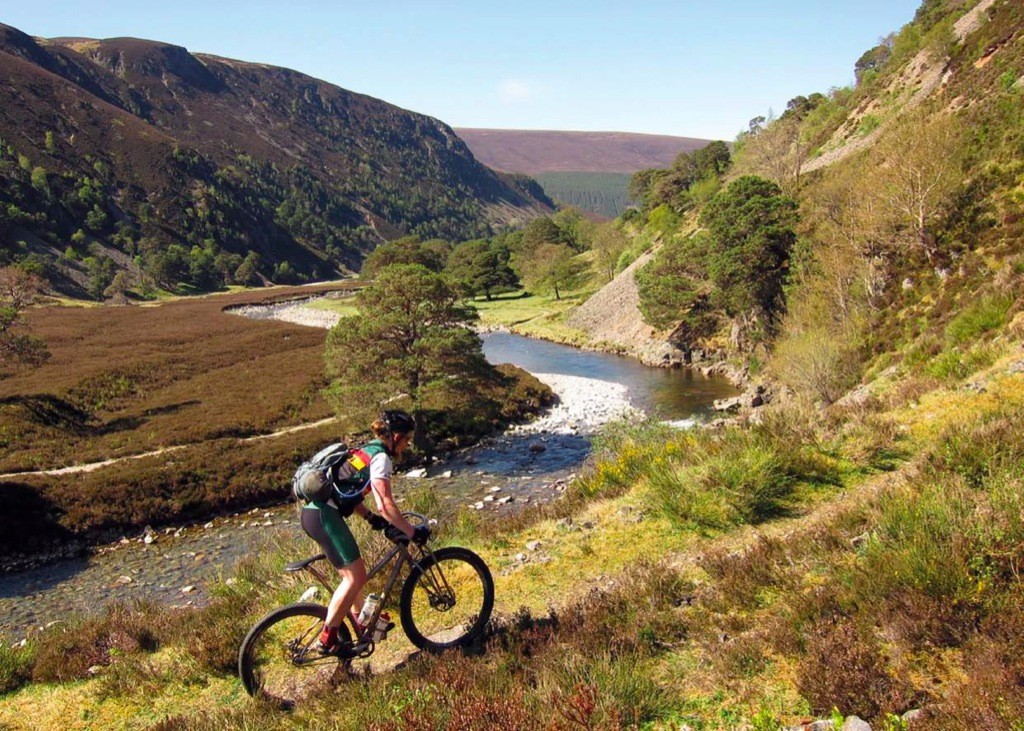


[i]Jon then went through a succession of Konas very quickly. Changing things really, really rapidly. Eventually running them as bodged single speeds.[/i]
“waves” – still have the surplus to stock Kilauea..